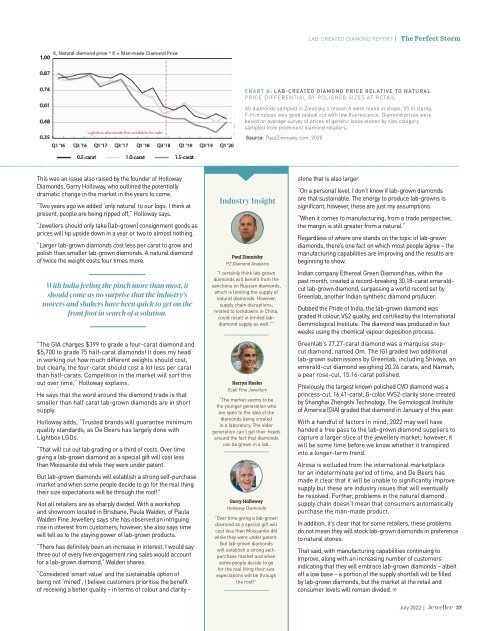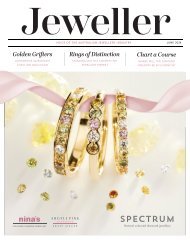Jeweller - July 2022
Door wide open: Lab-grown diamonds have a unique chance to thrive The Ego Game: Personalised jewellery is as popular as ever seen Avoid the trap: The business world is full of cliches - it's time to move on
Door wide open: Lab-grown diamonds have a unique chance to thrive
The Ego Game: Personalised jewellery is as popular as ever seen
Avoid the trap: The business world is full of cliches - it's time to move on
Create successful ePaper yourself
Turn your PDF publications into a flip-book with our unique Google optimized e-Paper software.
LAB-CREATED DIAMOND REPORT | The Perfect Storm<br />
CHART A: LAB-CREATED DIAMOND PRICE RELATIVE TO NATURAL<br />
PRICE DIFFERENTIAL BY POLISHED SIZES AT RETAIL<br />
All diamonds sampled in Zimnisky's research were round in shape, VS in clarity,<br />
F-H in colour, very good toideal cut with low fluorescence. Diamond prices were<br />
based on average survey of prices of generic loose stones by size category<br />
sampled from prominent diamond retailers.<br />
Source: PaulZimnisky.com, 2020<br />
This was an issue also raised by the founder of Holloway<br />
Diamonds, Garry Holloway, who outlined the potentially<br />
dramatic change in the market in the years to come.<br />
“Two years ago we added ‘only natural’ to our logo. I think at<br />
present, people are being ripped off,” Holloway says.<br />
“<strong>Jeweller</strong>s should only take [lab-grown] consignment goods as<br />
prices will tip upside down in a year or two to almost nothing.<br />
“Larger lab-grown diamonds cost less per carat to grow and<br />
polish than smaller lab-grown diamonds. A natural diamond<br />
of twice the weight costs four times more.<br />
With India feeling the pinch more than most, it<br />
should come as no surprise that the industry’s<br />
movers and shakers have been quick to get on the<br />
front foot in search of a solution.<br />
“The GIA charges $399 to grade a four-carat diamond and<br />
$5,700 to grade 75 half-carat diamonds! It does my head<br />
in working out how much different weights should cost,<br />
but clearly, the four-carat should cost a lot less per carat<br />
than half-carats. Competition in the market will sort this<br />
out over time,” Holloway explains.<br />
He says that the word around the diamond trade is that<br />
smaller than half carat lab-grown diamonds are in short<br />
supply.<br />
Holloway adds, “Trusted brands will guarantee minimum<br />
quality standards, as De Beers has largely done with<br />
Lightbox LGDs.<br />
“That will cut out lab grading or a third of costs. Over time<br />
giving a lab-grown diamond as a special gift will cost less<br />
than Moissanite did while they were under patent.<br />
But lab-grown diamonds will establish a strong self-purchase<br />
market and when some people decide to go for the real thing<br />
their size expectations will be through the roof!"<br />
Not all retailers are as sharply divided. With a workshop<br />
and showroom located in Brisbane, Paula Walden, of Paula<br />
Walden Fine <strong>Jeweller</strong>y, says she has observed an intriguing<br />
rise in interest from customers, however, she also says time<br />
will tell as to the staying power of lab-grown products.<br />
“There has definitely been an increase in interest, I would say<br />
three out of every five engagement ring sales would account<br />
for a lab-grown diamond,” Walden shares.<br />
“Considered ’smart value’ and the sustainable option of<br />
being not ‘mined', I believe customers prioritise the benefit<br />
of receiving a better quality – in terms of colour and clarity –<br />
Industry Insight<br />
Paul Zimnisky<br />
PZ Diamond Analytics<br />
“I certainly think lab-grown<br />
diamonds will benefit from the<br />
sanctions on Russian diamonds,<br />
which is limiting the supply of<br />
natural diamonds. However,<br />
supply chain disruptions,<br />
related to lockdowns in China,<br />
could result in limited labdiamond<br />
supply as well."”<br />
Kerryn Hasler<br />
Ecali Fine <strong>Jeweller</strong>y<br />
“The market seems to be<br />
the younger generation who<br />
are open to the idea of the<br />
diamonds being created<br />
in a laboratory. The older<br />
generation can’t get their heads<br />
around the fact that diamonds<br />
can be grown in a lab.<br />
Garry Holloway<br />
Holloway Diamonds<br />
“Over time giving a lab-grown<br />
diamond as a special gift will<br />
cost less than Moissanite did<br />
while they were under patent.<br />
But lab-grown diamonds<br />
will establish a strong selfpurchase<br />
market and when<br />
some people decide to go<br />
for the real thing their size<br />
expectations will be through<br />
the roof!”<br />
stone that is also larger.<br />
“On a personal level, I don’t know if lab-grown diamonds<br />
are that sustainable. The energy to produce lab-growns is<br />
significant, however, these are just my assumptions.<br />
“When it comes to manufacturing, from a trade perspective,<br />
the margin is still greater from a natural.”<br />
Regardless of where one stands on the topic of lab-grown<br />
diamonds, there’s one fact on which most people agree – the<br />
manufacturing capabilities are improving and the results are<br />
beginning to show.<br />
Indian company Ethereal Green Diamond has, within the<br />
past month, created a record-breaking 30.18-carat emeraldcut<br />
lab-grown diamond, surpassing a world record set by<br />
Greenlab, another Indian synthetic diamond producer.<br />
Dubbed the Pride of India, the lab-grown diamond was<br />
graded H colour, VS2 quality, and certified by the International<br />
Gemmological Institute. The diamond was produced in four<br />
weeks using the chemical vapour deposition process.<br />
Greenlab’s 27.27-carat diamond was a marquise stepcut<br />
diamond, named Om. The IGI graded two additional<br />
lab-grown submissions by Greenlab, including Shivaya, an<br />
emerald-cut diamond weighing 20.24 carats, and Namah,<br />
a pear rose-cut, 15.16-carat polished.<br />
Previously, the largest known polished CVD diamond was a<br />
princess-cut, 16.41-carat, G-color, VVS2-clarity stone created<br />
by Shanghai Zhengshi Technology. The Gemological Institute<br />
of America (GIA) graded that diamond in January of this year.<br />
With a handful of factors in mind, <strong>2022</strong> may well have<br />
handed a free pass to the lab-grown diamond suppliers to<br />
capture a larger slice of the jewellery market; however, it<br />
will be some time before we know whether it transpired<br />
into a longer-term trend.<br />
Alrosa is excluded from the international marketplace<br />
for an indeterminate period of time, and De Beers has<br />
made it clear that it will be unable to significantly improve<br />
supply but these are industry issues that will eventually<br />
be resolved. Further, problems in the natural diamond<br />
supply chain doesn’t mean that consumers automatically<br />
purchase the man-made product.<br />
In addition, it’s clear that for some retailers, these problems<br />
do not mean they will stock lab-grown diamonds in preference<br />
to natural stones.<br />
That said, with manufacturing capabilities continuing to<br />
improve, along with an increasing number of customers<br />
indicating that they will embrace lab-grown diamonds – albeit<br />
off a low base – a portion of the supply shortfall will be filled<br />
by lab-grown diamonds, but the market at the retail and<br />
consumer levels will remain divided.<br />
<strong>July</strong> <strong>2022</strong> | 37


















